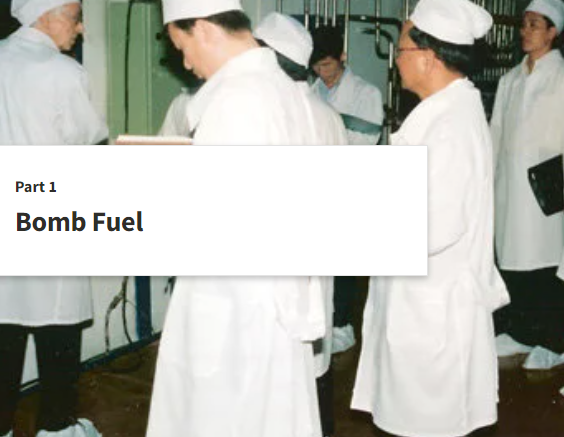Hinge Points: An Inside Look at North Korea’s Nuclear Program
Bomb Fuel
The production of plutonium bomb fuel requires a large infrastructure, including uranium mines, chemical processing facilities to prepare uranium (or uranium oxide) reactor fuel, nuclear reactors to produce plutonium, and chemical facilities to reprocess (or extract) that plutonium from the spent (used) reactor fuel. The production of highly enriched uranium requires the same front-end mining and uranium chemical processing facilities together with uranium enrichment capabilities. Uranium ore consists of 99.3 % of the isotope Uranium-238 and 0.7 % Uranium-235. Uranium for bomb fuel must be concentrated in the isotope U-235 to a level of roughly 90 % because this isotope is “fissile,” meaning that it can be made to split (or fission) by neutron bombardment over a large range of energies. Uranium-235 and U-238 are virtually identical chemically but differ in their physical properties, notably their mass. The slight difference in mass allows the isotopes to be separated and makes it possible to increase (or enrich) the percentage of U-235.
Plutonium is produced in nuclear reactors when U-238 reactor fuel absorbs a neutron and transmutes to element plutonium. Gas-graphite reactor designs such as Yongbyon’s 5 MWe reactor can use natural uranium as fuel combined with a graphite moderator that slows neutrons sufficiently to sustain a chain reaction. For electricity production, it is much more effective to enrich natural uranium to 3 to 5 % U-235 combined with light water as a moderator, and typically also as the coolant. Reactors produce plutonium in combination with numerous fission products that reside in the used (spent) uranium fuel. To be used for nuclear weapons, the plutonium must be separated chemically from that mix in a process called reprocessing of spent fuel.
Centrifuges have become the technology of choice to enrich uranium from its 0.7 % U-235 content in natural uranium to 90 % in weapon-grade uranium by taking advantage of the slight mass differences in the isotopes. Centrifuges rapidly spin, at almost 100,000 rpm, the uranium-containing gas uranium hexafluoride (UF6) to separate the heavy from the light isotope in a cascade of spinning centrifuges. North Korea is one of a small number of countries that has developed this technologically challenging capability. The most common electricity production reactors today are light water reactors. The centrifuge technologies required for producing the low-enriched uranium (LEU) fuel for these reactors are the same as those capable of producing HEU – only the details of the centrifuge cascades differ.
In addition to the fissile materials discussed above, hydrogen bombs require isotopes of hydrogen, namely deuterium and tritium, for fusion bomb fuel. These isotopes can also be used to enhance the yield of a fission bomb by a process called boosting, that is, having fission produce some fusion, which in turn helps to boost further fission reactions. Deuterium is a stable isotope of hydrogen that contains a neutron in addition to the proton present in the hydrogen nucleus. Deuterium accounts for approximately 0.02% (0.03% by mass) of all naturally occurring hydrogen in ocean waters. Its separation from hydrogen was demonstrated some 90 years ago. Tritium consists of a proton and two neutrons. It is unstable and radioactively decays with a half-life (the time for half of it to decay and transmute to something else) of 12.32 years. It is readily produced by bombarding Lithium-6 with neutrons and then separated. Deuterium and tritium will be the essential fuel for civilian nuclear fusion reactors of the future. Tritium is also used as a radioactive tracer and in radioluminescent light sources for watches and instruments.
The reactors and enrichment facilities together with all ancillary facilities are typically referred to as the fuel cycle, or front end of nuclear applications. [1] These fuel-cycle facilities require significant financial investments and technical manpower. Some of the facilities, such as reactors or reprocessing facilities, have reasonably large footprints that can be detected by the national technical means of verification employed by intelligence agencies or by commercial satellite imagery. Others, such as centrifuge facilities, have very small footprints and are easily hidden.
Source:
[1] Hecker, Siegfried S., Matthias Englert, and Michael C. Miller, Materials Research Society, Chapter 14: “Nuclear Nonproliferation,” in textbook Fundamentals of Materials for Energy and Environmental Sustainability. Eds. David S. Ginley and David Cahen. Cambridge UP: 2012.
